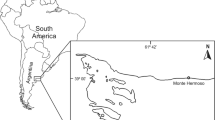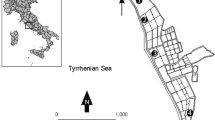Abstract
In aquatic ecosystems, the ecology of macrophytal detritus aggregations has been investigated over a range of temporal scales. Yet, no attempts have been made to minimize the temporal resolution of the analysis, thus neglecting the occurrence of short-term colonization and decay dynamics for these ephemeral patches of high biological activity. The present study was carried out at two sampling sites in Lake Alimini Grande, a brackish lagoon in South-East Italy. The abundance of macroinvertebrate taxa colonizing prepared packs of reed leaf detritus and the ash-free dry mass of the packs were monitored daily for 40 days. Spectral analysis was used to investigate the fine-scale temporal dynamics of invertebrates colonization and leaf pack mass variations. The macrobenthos found on leaf packs was dominated at both sites by few taxa (i.e., the vagile Lekanesphaera monodi, Microdeutopus gryllotalpa, Neanthes caudata and the sessile Balanus sp.), whose general colonization patterns were described by unimodal curves. At a daily temporal resolution Balanus sp. was characterized by random short-term density variations, while vagile taxa showed non-random, highly site- and species-specific fluctuations generally characterized by an oscillation period comprised between 2 and 3 days. In addition, leaf packs were characterized by non-random, short-term mass oscillations, coherent and in phase with L. monodi abundance fluctuations. Our results highlight the occurrence of short-term, non-random density variations of invertebrate colonizers on leaf detritus patches. In addition, they emphasize a previously unexplored, fine-scale linkage between abundance patterns of invertebrate consumers and short-term mass variations of decaying detritus.







Similar content being viewed by others

References
Albay M, Akcaalan R (2003) Comparative study of periphyton colonisation on common reed (Phragmites australis) and artificial substrate in a shallow lake, Manyas, Turkey. Hydrobiologia 506:531–540
Bärlocher F (1985) The role of fungi in the nutrition of stream invertebrates. Bot J Linn Soc 91:83–94
Bärlocher F, Kendrick B (1981) The role of aquatic hyphomycetes in trophic structure of stream. In: Wicklow DT, Carrol GC (eds) The fungal community, its organisation and role in the ecosystem. Marcel Dekker, New York
Basset A (1994) Mole corporea ed organizzazione delle guild a base detrito all’interfaccia terra-acqua dolce. SITE Proc 16:155–160
Basset A (1995) Body size-related coexistence: an approach through allometric constraints on home-range use. Ecology 76:1027–1035
Basset A, Ponti A (1992) Sull’uso delle risorse da parte di detritivori bentonici: note introduttive sull’homerange di tre specie in rapporto alla mole corporea. Atti Seminario Facoltà Scienze Univ Cagliari 62:59–69
Basset A, DeAngelis DL, Diffendorfer J (1997) Stability and functional response of grazers on a landscape. Ecol Model 101:153–162
Bedford AP (2004) A modified litter bag design for use in lentic habitats. Hydrobiologia 529:187–193
Bjornstad ON, Stenseth NC, Saitoh T (1999) Synchrony and scaling in dynamics of voles and mice in northern Japan. Ecology 80:632–637
Boudouresque CF (1971) Mèthods d’ètude qualitiative et quantitative du benthos (en particulier du phytobenthos). Tèthys 3:79–104
Brown JS (1988) Patch use as an indicator of habitat preference, predation risk, and competition. Behav Ecol Sociobiol 22:37–47
Burnham KP, Anderson DR (2002) Model selection and multimodel Inference:a practical information-theoretic approach. Springer, Berlin Heidelberg New York
Carpenter SR (1982) Comparisons of equations for decay of particulate detritus in tree-hole ecosystems. Oikos 39:17–23
Charmantier G, Charmantier-Daures M (1994) Ontogeny of osmoregulation and salinity tolerance in the isopod crustacean Sphaeroma serratum. Mar Ecol Prog Ser 114:93–102
Connell JH (1961) The influence of interspecific competition and other factors on the distribution of the barnacle Chthamalus stellatus. Ecology 42:410–423
Costa MJ (1988) Ecologie alimentaire des poissons de l’estuarie du Tage. Cybium 12:301–320
DeAngelis DL (1992) Dynamics of Nutrient Cycling and Food Webs. Chapman and Hall, London
Diaz RJ, Rosenberg R (1995) Marine benthic hypoxia: a review of its ecological effects and the behavioural responses of benthic macrofauna. Oceanogr Mar Biol Annu Rev 33:245–303
van Dokkum HP, Slijkerman DME, Rossi L, Costantini ML (2002) Variation in the decomposition of Phragmites australis litter in a monomictic lake: the role of gammarids. Hydrobiologia 482:69–77
Dungan JL, Perry JN, Dale MRT, Legendre P, Citron-Pousty S, Fortin MJ, Jakomulska A, Miriti M, Rosenberg MS (2002) A balanced view of scale in spatial statistical analysis. Ecography 25:626–640
Eggert SL, Wallace JB (2003) Litter breakdown and invertebrate detritivores in a resource-depleted Appalachian stream. Arch Hydrobiol 156(3):315–338
Gessner MO, Chauvet E, Dobson M (1999) A perspective on leaf litter breakdown in streams. Oikos 85:377–384
Gonçalves JF, Santos AM, Esteves FA (2004) The influence of the chemical composition of Typha Domingensis and Nymphaea Ampla detritus on invertebrate colonization during decomposition in a brazilian coastal lagoon. Hydrobiologia 527:125–137
Graça MAS (1993) Patterns and processes in detritus-based stream systems. Limnologica 23:107–114
Graça MAS (2001) The role of invertebrates on leaf litter decomposition in streams—a review. Int Rev Gesamten Hydrobiol 86:383–393
Graça MAS, Newell SY, Kneib RT (2000) Grazing rates of organic matter and living fungal biomass of decaying Spartina alterniflora by three species of salt-marsh invertebrates. Mar Biol 136:281–289
Hieber M, Gessner M (2002) Contribution of stream detrivores, fungi, and bacteria to leaf breakdown based on biomass estimates. Ecology 83:1026–1038
Hochberg Y (1988) A sharper Bonferroni procedure for multiple tests of significance. Biometrika 76:297–307
Horne JK, Schneider DC (1995) Spatial variance in ecology. Oikos 74:18–26
Kittlein MJ (1991) Population biology of Sphaeroma serratum Fabricius (Isopoda, Flabellifera) at the Port of Mar de la Plata, Argentina. J Nat Hist 25:1449–1459
Levin SA (1992) The problem of pattern and scale in ecology. Ecology 73:1943–1967
Levinton JS, Kelaher B (2004) Opposing organizing forces of deposit-feeding marine communities. J Exp Mar Biol Ecol 300:65–82
MacArthur RH, Pianka ER (1966) On optimal use of a patchy environment. Am Nat 100:603–609
Mancinelli G, Rossi L (2001) Indirect, size-dependent effects of crustacean mesograzers on the Rhodophyta Gracilaria verrucosa (Hudson) Papenfuss: evidence from a short-term study in the Lesina Lagoon (Italy). Mar Biol 138:1163–1173
Mancinelli G, Rossi L (2002) The influence of allochthonous leaf detritus on the occurrence of crustacean detritivores in the soft-bottom macrobenthos of the Po River delta area (northwestern Adriatic Sea). Estuar Coast Shelf Sci 54:849–861
Mancinelli G, Costantini ML, Rossi L (2002) Cascading effects of predatory fish exclusion on the detritus-based food web of a lake littoral zone (Lake Vico, central Italy). Oecologia 133:402–411
Mason CF, Bryant RJ (1975) Production, nutrient content and decomposition of Phragmites Communis Trin. and Typha Angustifolia L. J Ecol 63:7195
Muller U (1999) The vertical zonation of adpressed diatoms and other epiphytic algae on Phragmites australis. Eur J Phycol 34:487–496
Murphy JF, Giller PS, Horan MA (1998) Spatial scale and the aggregation of stream macroinvertebrates associated with leaf packs. Freshwater Biol 39:325–337
Newell SY, Bärlocher F (1993) Removal of fungal and total organic matter from decaying cordgrass leaves by shredder snails. J Exp Mar Biol Ecol 171:39–49
Norkko J, Bonsdorff E, Norkko A (2000) Drifting algal mats as an alternative habitat for benthic invertebrates: species specific responses to a transient resource. J Exp Mar Biol Ecol 248:79–104
Okey TA (2003) Macrobenthic colonist guilds and renegades in Monterey Canyon drift algae: partitioning multidimensions. Ecol Monogr 73:125–150
Paine RT, Levin SA (1981) Intertidal landscapes: disturbance and the dynamics of pattern. Ecol Monogr 51:145–178
Palmer MA, Swan CM, Nelson K, Silver P, Alvestad R (2000) Streambed landscapes: evidence that stream invertebrates respond to the type and spatial arrangement of patches. Landscape Ecol 15:563–576
Parsons M, Thoms MC, Norris RH (2004) Using hierarchy to select scales of measurement in multiscale studies of stream macroinvertebrate assemblages. J N Am Benthol Soc 23:157–170
Pope RJ, Gordon AM, Kaushik NK (1999) Leaf litter colonization by invertebrates in the littoral zone of a small oligotrophic lake. Hydrobiologia 392:99–112
Priestley MB (1981) Spectral analysis and time series. Academic, London
Robinson CT, Gessner MO, Ward JV (1998). Leaf breakdown and associated macroinvertebrates in alpine glacial streams. Freshwater Biol 40:215–228
Rossi L, Costantini ML (2000) Mapping intra-habitat variation of leaf mass loss rate in a brackish Mediterranean lake. Mar Ecol Prog Ser 203:145–159
Royer TV, Minshall GW (2003) Controls on leaf processing in streams from spatial-scaling and hierarchical perspectives. J N Am Benthol Soc 22:352–358
Rundle SD, Bilton DT, Shiozawa D (2000) Global and regional patterns in lotic meiofauna. Freshwater Biol 44:123–134
Salen-Picard C, Darnaude AM, Arlhac D, Harmelin-Vivien ML (2002) Fluctuations of macrobenthic populations: a link between climate-driven river run-off and sole fishery yields in the Gulf of Lions. Oecologia 133:380–388
Sampaio A, Cortes RL (2004) Yeast and macroinvertebrate communities associated with leaf litter decomposition in a second order stream. Int Rev Hydrobiol 89:453–466
Sangiorgio F (2004) Ruolo della mole corporea individuale nell’organizzazione di comunità a base detrito. Ph.D. Thesis, University of Lecce, Italy
Schneider DC (2001) The rise of the concept of scale in ecology. Bioscience 51:545–553
Schoener TW (1987) A brief history of optimal foraging theory. In: Kamil AC, Krebs JR, Pulliam HR (eds) Foraging behaviour. Plenum Press, NY, pp 5–67
Sousa WP (1984) The role of disturbance in natural communities. Annu Rev Ecol Syst 15:353–391
Stephens DW, Krebs JR (1986) Foraging theory. Princeton University Press, Princeton
Stockwell JD, Burkey TV, Cazelles B, Menard F, Ascioti FA, Himschoot P, Wu J (1995) Detecting periodicity in quantitative versus semi-quantitative time series. In: Powell TM, Steele JH (eds) Ecological time series. Chapman and Hall, New York, pp 99–115
Suberkropp K (1992) Interactions with invertebrates. In: Bärlocher F (ed) The ecology of aquatic hyphomycetes. Springer, Berlin Heidelberg New York, pp 118–134
Suberkropp K (1998) Effect of dissolved nutrients on two aquatic hyphomycetes growing on leaf litter. Mycol Res 102:998–1002
Suberkropp K, Chauvet E (1995) Regulation of leaf breakdown by fungi in streams—influences of water chemistry. Ecology 76:1433–1445
Swan CM, Palmer MA (2000) What drives small-scale patterns in lotic meiofauna communities? Freshwater Biol 44:109–121
Thrush SE (1999) Complex role of predators in structuring soft-sediment macrobenthic communities: implications of changes in spatial scale for experimental studies. Aust J Ecol 24:344–354
Tokeshi M (1999) Species coexistence: ecological and evolutionary perspectives. Blackwell Science, Oxford
Tuchman NC, Wahtera KA, Wetzel RG, Teeri JA (2003) Elevated atmospheric CO2 alters leaf litter quality for stream ecosystems: an in situ leaf decomposition study. Hydrobiologia 495:203–211
Varga I (2001) Macroinvertebrates in reed litter. Int Rev Gesamten Hydrobiol 86:573–583
Vetter EW, Dayton PK (1999) Organic enrichment by macrophyte detritus, and abundance patterns of megafaunal populations in submarine canyons. Mar Ecol Prog Ser 186:137–148
Wallace JB, Webster JR (1996) The role of macroinvertebrates in stream ecosystem function. Annu Rev Entomol 41:115–139
WallisDeVries MF, Laca EA, Demment MW (1999) The importance of scale of patchiness for selectivity in grazing herbivores. Oecologia 121:355–363
Webster JR (1983) The role of benthic macroinvertebrates in detritus dynamics of streams: a computer simulation. Ecol Monogr 53:383–404
Wiens JA (1989) Spatial scaling in ecology. Funct Ecol 3:385–397
Zar JH (1998) Biostatistical analysis. Prentice Hall, Englewood Cliffs
Acknowledgments
We are grateful to Franca Sangiorgio for kindly providing chemical and physical data on the Lake Alimini system. We also thank two anonymous reviewers for constructive comments that greatly improved the manuscript. Funding from EEC grant ENV-CT97-0584 is acknowledged. This paper is dedicated to the memory of Ennio Mancinelli.
Author information
Authors and Affiliations
Corresponding author
Additional information
Communicated by R. Cattaneo-Vietti, Genova
Rights and permissions
About this article
Cite this article
Mancinelli, G., Sabetta, L. & Basset, A. Short-term patch dynamics of macroinvertebrate colonization on decaying reed detritus in a Mediterranean lagoon (Lake Alimini Grande,Apulia, SE Italy). Marine Biology 148, 271–283 (2005). https://doi.org/10.1007/s00227-005-0091-5
Received:
Accepted:
Published:
Issue Date:
DOI: https://doi.org/10.1007/s00227-005-0091-5



